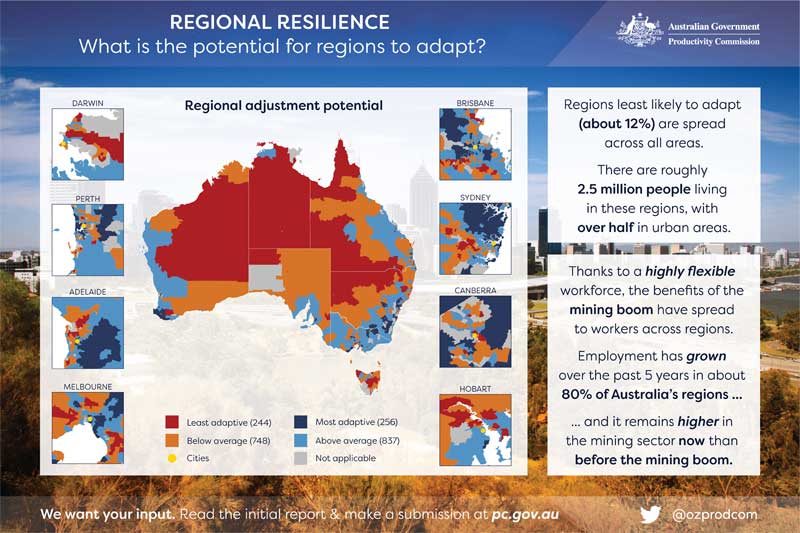Transitioning regional economies
Initial report
This initial report was released on 21 April 2017. You were invited to examine the initial report and to make written submissions by 31 July 2017.
Please note: This position paper is for research purposes only. For final outcomes of this study refer to the study report.
Download the overview
- Overview - Transitioning Regional Economies - Initial report (PDF - 1204 Kb)
- Overview - Transitioning Regional Economies - Initial report (Word/Zip - 1430 Kb)
Download the initial report
- Transitioning Regional Economies - Initial report (PDF - 4410 Kb)
- Transitioning Regional Economies - Initial report (Word/Zip - 6313 Kb)
Technical supplement
Described in this technical supplement are the data and techniques used to construct the single metric of regional adaptive capacity.
Key Points
- The mining boom has caused transitional pressures, but it has also made Australians substantially better off in the long term. A mobile workforce (including fly-in, fly-out) has spread the benefits of the boom across workers living in other regions, as well as reduced the cost of both the investment phase and the ongoing production phase.
- About 80 per cent of regions have had positive employment growth over the past five years.
- Even though overall employment growth has been positive, all regions have had highly variable growth in employment over time, with most also experiencing decreases at times.
- Adjustment from the mining boom may not be the largest source of dissatisfaction outside of capital cities. Over the past five years, employment and population falls are evident in some agricultural and a small number of mining regions.
- In agriculture, employment decline is driven by efficiencies and technological innovation, leading to growth in production using less labour. At the same time, there has been a pattern of consolidation from smaller towns to larger regional centres, affecting the social fabric of these communities and engendering a feeling of being left behind as Australia prospers more generally.
- Caution is required if making policy decisions based on the rankings of regions using the estimated metric of relative adaptive capacity in this initial report. There is unavoidable uncertainty about its estimated value for each region, and actual adaption to any specific disruption would be affected by factors beyond the metric.
- The factors shaping adaptive capacity include: people-related factors (educational achievement, employment rates, skill levels, personal incomes and community cohesion); the degree of remoteness and accessibility to infrastructure and services; natural endowments (such as agricultural land) and industry diversity.
- Most mining regions appear to be resilient and have relatively high adaptive capacity.
- Regions with a greater dependency on manufacturing have relatively low adaptive capacity.
- Remote and very remote regions (including Indigenous communities) also tend to have relatively low adaptive capacity.
- There is no 'one size fits all' approach that will promote successful adaptation in all regions, although there are 'no-regrets' policies that should be pursued as soon as practicable.
- Strategies for successful adaptation and development are those that focus on supporting people in regional communities to adjust to changing economic circumstances. Strategies work best when they are:
- identified and led by the local community, in partnership with all levels of government
- aligned with the region's relative strengths
- supported by targeted investment in developing the capability of the people in the local community to deal with transition, adaptation, and securing an economic future
- designed with clear objectives and measurable performance indicators and subject to rigorous evaluation.
- Although government expenditure on projects can create short-term employment, it often does little to support transition and long-term sustainable growth in regions.
- The initial findings in this report could change when data from the 2016 Census of Population and Housing become available in October and further research is undertaken.


